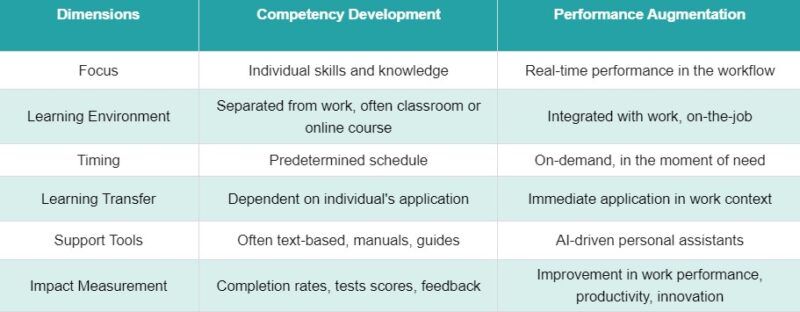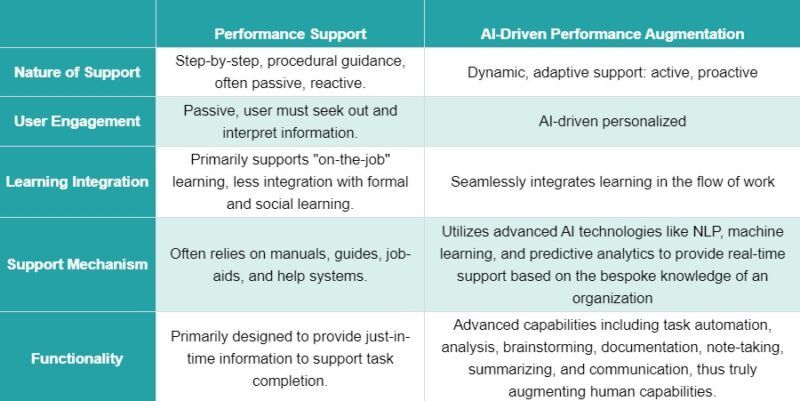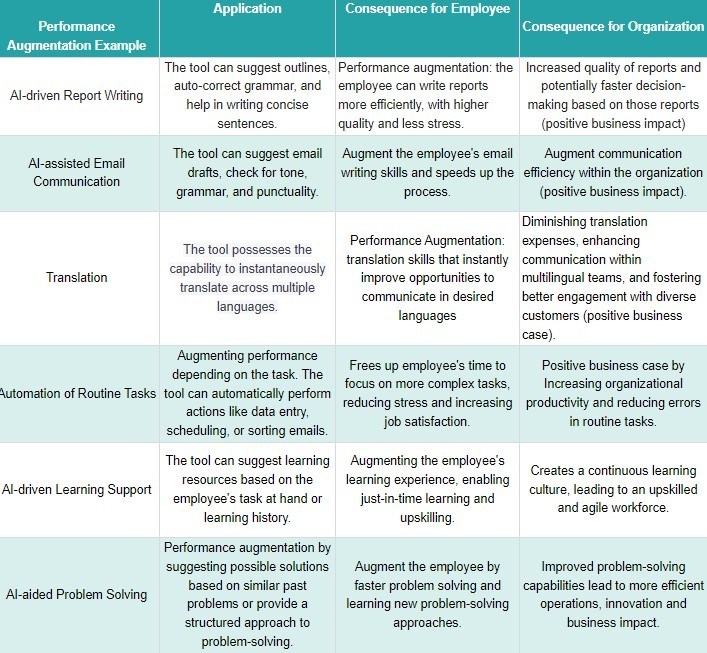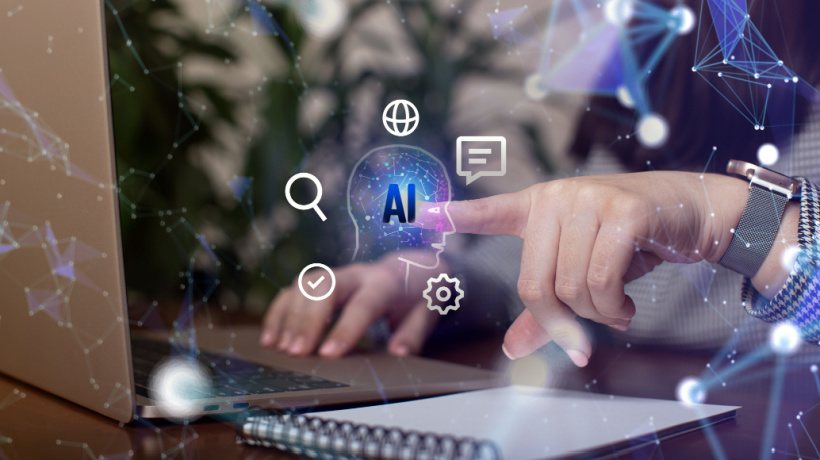AI-Driven Performance Augmentation
Welcome back to part seven (find part six here) of our ongoing exploration of the transformative role of Artificial Intelligence (AI) in Learning and Development (L&D). As we journey forward, we're reminded of Steve Jobs' compelling metaphor, where he likened computers to a "bicycle for our minds", amplifying our abilities in unprecedented ways. This metaphor elegantly extends to AI in L&D, and in this seventh installment, we shift gears to focus on the fascinating concept of AI-driven performance augmentation. As we delve deeper into this concept, we begin to realize that it is not just about learning for the sake of learning, but about learning that is tightly interwoven with work, thereby driving both personal/team growth and organizational performance.
Performance Augmentation
Performance augmentation, a process of enhancing or improving human abilities through various interventions (Hancock, 2019), is progressively making waves across multiple domains, including sports, healthcare, manufacturing, and more recently, in the realm of corporate learning. In the world of sports, it is likely that the coming decades will see continued growth in efforts to augment the abilities of humans with ever more complex technology in a range of scenarios (Ryan, et al., 2023). Performance augmentation in sports often involves the use of real-time data and feedback provided by wearable technology, enabling athletes to refine their techniques (Bishop, 2019). Similarly, in healthcare, AI-driven predictive analytics is increasingly used to augment patient care and outcomes, by predicting potential health risks and providing preventative measures (Shortliffe and Sepúlveda, 2018).
Competency Development And Performance Augmentation In Corporate Learning
In traditional corporate learning practices, the emphasis often lies on competency development, focusing on improving the knowledge, skills, and abilities of employees (ATD, 2022). This model emphasizes the individual developing competencies necessary to perform tasks relevant to their roles.
Performance augmentation, however, brings forth a paradigm shift. Instead of primarily concentrating on individuals' competencies, performance augmentation underscores the enhancement of real-time performance within the context of work. By embedding learning within the workflow and leveraging the power of AI, performance augmentation catalyzes the immediate application of learning and ensures that support is available just when it is needed. It transcends the realm of mere competence to enable employees to perform tasks more efficiently, effectively, innovatively, and enjoyably. Let's illustrate this shift from competency development to performance augmentation in Table 1.

Table 1: The shift from competency development to performance augmentation
As this table indicates, the move towards performance augmentation signifies a seismic shift for L&D. It requires a reconfiguration of traditional models and strategies and a renewed focus on integrating learning seamlessly with work. L&D professionals will need to become adept at leveraging AI technologies and reorient their metrics toward work performance improvements.
Case
In today's fast-paced banking sector, the managerial staff at Centurion Bank, a major global financial institution, found themselves overburdened with the escalating demands of regulatory compliance and risk management. From generating comprehensive reports to analyzing complex data for decision-making, these tasks required significant time and effort, thereby limiting the managers' abilities to focus on strategic initiatives and client relationships.
Recognizing this challenge, the L&D team at Centurion Bank saw an opportunity to leverage performance augmentation through an AI-driven personal assistant, "ReguAide". ReguAide was designed to automate the generation of regulatory reports, analyze risk trends, and proactively flag potential compliance issues. The AI tool was equipped to handle vast amounts of data and was programmed with an understanding of regulatory frameworks, banking practices, and risk parameters.
The impact of this performance augmentation on the managerial staff was transformative. With ReguAide, managers could produce accurate reports in a fraction of the time, interpret complex risk trends swiftly, and be proactive in their compliance efforts. This saved valuable time, allowing managers to devote more energy to strategic planning, client interactions, and leadership roles. At an organizational level, Centurion Bank experienced a significant decrease in compliance-related errors and a rise in regulatory confidence, resulting in improved reputation and customer trust. The increased time for strategic initiatives also led to innovative solutions and enhanced client satisfaction.
The L&D team at Centurion Bank was lauded for this groundbreaking initiative. They had identified a core challenge and addressed it using AI-driven performance augmentation, thereby strengthening the bank's compliance strategy and freeing up managerial resources for more valuable tasks. In this case, it was vital that managers had the competencies to interpret and refine the outputs from ReguAide. The L&D team's role in preparing managers to effectively utilize AI tools and understand their output underscored the synergy between competency development and performance augmentation. This case demonstrates how performance augmentation can revolutionize the way L&D functions in organizations, delivering solutions that dramatically improve individual performance and have a significant impact on the organization's efficiency and success.
From Performance Support Toward Performance Augmentation
As we venture deeper into the transformative power of AI in reshaping performance support, we are led to a significant realization. AI does not merely support, but actively augments performance. This augmentation is much more than a technological shift. It signifies a profound change in the way we perceive learning and working, no longer siloed, but seamlessly interwoven. This is not about providing passive assistance, but a proactive, personalized engagement that enhances users' capabilities, paving the way for what we propose to call "performance augmentation." The following table articulates this shift from traditional performance support to performance augmentation enabled by AI-driven personal assistants. It provides a comprehensive comparison across key dimensions, the nature of support, user engagement, integration of learning within work, support mechanism, and functionality. As we delve into these dimensions, we not only observe the technological advancements but also the fundamental paradigm shift in the learning and working landscape.

Table 2: From performance support towards AI-driven performance augmentation
Active And Proactive Performance Augmentation
Active performance augmentation refers to the AI assistant's ability to respond to direct prompts or commands from the user. For instance, a user might ask the AI assistant to find a piece of information, complete a routine task, or analyze data. The AI assistant actively fulfills these requests, thereby augmenting the user's performance by saving time, minimizing error, and enhancing productivity.
On the other hand, proactive performance augmentation takes the concept one step further. Here, the AI assistant anticipates the user's needs and helps even before being asked. This is done by leveraging data and Machine Learning algorithms to understand the user's patterns, preferences, and work routines. For instance, a proactive AI assistant might alert a user to an impending deadline, suggest resources for a project based on the user's past preferences, or even automate routine tasks without being explicitly asked to do so. This proactive assistance can significantly streamline workflows, minimize oversights, and enhance efficiency, thereby taking performance augmentation to the next level.
In both active and proactive performance augmentation, the goal is to seamlessly integrate AI assistance within the flow of work, thereby enhancing the user's capabilities and productivity. The shift from traditional passive support to active and proactive performance augmentation with AI presents significant opportunities for transforming how we work and learn.
Examples, Advantages, And Limitations
Get ready to explore a world where work seamlessly integrates with learning, where performance support evolves into performance augmentation, and where the advantages of AI's proactive and personalized support are no longer a thing of distant future, but a living, breathing reality of today's corporate landscape. See Table 3 for a list of real-life examples of AI-driven performance augmentation.

Table 3: Examples of performance augmentation
Advantages Of Performance Augmentation
For employees, experiencing performance augmentation could lead to a remarkable increase in their skill level, boosting their confidence and enhancing their job satisfaction. With improved skills in report writing, email communication, and other routine tasks, employees would find it easier to meet their performance expectations and contribute effectively to the organization.
Moreover, it can aid in automating routine tasks, freeing up time for employees to focus on more complex and strategic tasks. By providing just-in-time support, performance augmentation can reduce the cognitive load on the employee and enhance overall work performance. For the organization, this could mean increased productivity, reduced error rates, and improved employee satisfaction.
Limitations Of Performance Augmentation
Despite the significant advantages, performance augmentation is not without its limitations. The success of AI-driven support is largely contingent on the quality of the AI tool and its alignment with the specific work context. Misalignment could lead to inaccurate guidance, which may adversely impact work performance (Davenport and Kirby, 2016). Moreover, there is a risk of overreliance on AI tools, potentially limiting the development of critical thinking and problem-solving skills.
No Competition Between Competency Development And Performance Augmentation
The journey from competency development to performance augmentation is not one of substitution but of evolution. It is crucial to understand that while these two constructs exist in a continuum, they are not competing. Instead, they represent a harmonious synergy, where competency development forms the bedrock upon which performance augmentation is established. Advocating for a synergistic approach, we propose a conscientious integration of competency development and performance augmentation, informed by an evidence-based instructional systems design (ISD) model, like "ten steps to complex learning" (Merriënboer and Kirschner, 2018).
In our present-day work environment, the role of performance augmentation amplified by Artificial Intelligence becomes even more critical and influential. However, to appraise and leverage the output provided by these AI assistants, workers must have a certain level of competency. This underlines the crucial role of competency development in enabling performance augmentation: it is a competent worker who can assess and refine the output of the AI assistant to ensure it meets their specific work context needs.
Calculator: An Illustration Of Competency-Dependent Performance Augmentation
The adoption of calculators in the education sector wasn't always as accepted as it is today. Educators initially feared that allowing calculator use would undermine the fundamental skills students needed to develop, such as manual calculation and numerical reasoning (Hancock, 2019). Consequently, calculator use was restricted, especially in early education. Over time, however, perspectives shifted as the benefits of calculator use became more evident. Rather than stunting the development of numerical skills, calculators could serve as a tool for better understanding mathematical concepts and improving computational accuracy (Hancock, 2019). As a result, the calculator has become a widely accepted performance augmentation tool across all educational levels, proving to be a beneficial asset in mathematical learning.
While calculators are universally helpful, their value proposition varies significantly depending on the competency level of the user. A primary school student might use a calculator for simple arithmetic, while a mathematician could use the same tool to solve complex mathematical functions such as factorials, trigonometric functions, logarithms, and more. This discrepancy highlights the principle that the value derived from performance augmentation tools is contingent upon the user's competency level (Bishop, 2019). For example, the utility of advanced functions in a calculator, like trigonometric calculations or statistical functions, is contingent on the user's understanding of these concepts. A user unaware of trigonometric principles won't gain much benefit from a calculator's sine, cosine, or tangent functions. Conversely, a user well-versed in these principles can leverage these functions to solve complex problems quickly and accurately (Shortliffe and Sepúlveda, 2018).
The calculator serves as an engaging example of how competency levels influence the utility of performance augmentation tools. It emphasizes the importance of underlying knowledge and skills in maximizing the benefits of such tools. While technology can significantly augment performance, the potential of these tools is inherently linked to the user's competency level, making a compelling case for the continued importance of fundamental skills and knowledge in an increasingly technologized educational environment.
The Business Case For Performance Augmentation
Performance augmentation by AI-driven personal assistants provides an extensive array of benefits across various categories. Examples of these benefits are the foundational elements for creating a compelling business case in both quantitative and qualitative ways.
Time, Money, And Resource Savings
- Information retrieval
Instant access to vital data eliminates extensive search times. - Reporting
Supported writing of reports saves valuable staff time and resources. - Translation services
Real-time translations remove the need for manual or third-party translation services.
Workload Reduction
- Task automation
Repetitive and mundane tasks can be handled by AI, freeing up employees for more complex work. - Intelligent assistance
Provides instant support and answers, reducing time spent on problem-solving.
Error Reduction
- Data accuracy
Reduces human error in data entry and calculation. - Quality control
Supported checking for consistency and accuracy in documentation and processes. - Predictive analytics
Anticipates issues and errors before they occur, allowing for proactive measures.
Improved And Faster Communication
- Automated client communication
Sends notifications, reminders, and updates to clients efficiently. - Internal communication automation
Enhances internal coordination and collaboration. - Multilingual support
Enables seamless communication across different languages, broadening market reach.
Example Business Case: Nursing Homes
In a nursing home environment, where caregivers are responsible for multiple patients, time is precious, and quality care is paramount. Here's how performance augmentation could play a role:
- Quantitative benefits
Assume 3000 employees with an average annual salary of $48,000. Implementing AI-driven personal assistants could result in a conservative 7% time saving, translating to $3,360 saved per employee. Total monetary value saved would be $10.08 million annually, minus the cost of the AI-solution. - Qualitative benefits
- Enhanced patient care
By reducing workload through automated documentation, scheduling, writing of nursing plans, and automated reporting, caregivers can spend more quality time with patients. - Patient education and information
AI-driven assistants can provide personalized health education and updates to patients, enhancing their understanding and participation in their care. - Reduced errors
Ensuring medication schedules, dietary restrictions, nursing plans, and care reports are accurately followed and generated. - Multilingual communication
Facilitating better communication with patients and family members who may not speak the primary language of the facility. - Personalized learning for staff
Ongoing education tailored to each caregiver's needs, leading to professional development and retention.
- Enhanced patient care
In this context of a larger nursing home, the deployment of AI-driven personal assistants for performance augmentation can lead to both significant monetary savings and qualitative improvements in patient care, employee satisfaction, and overall efficiency. This is a clear demonstration of the potential of AI in transforming the healthcare industry, particularly in caregiving sectors.
Conclusion
Competency development and performance augmentation are two sides of the same coin. While competencies form the bedrock, performance augmentation builds upon this foundation, directly enhancing work performance. This synergy between learning and augmenting performance is critical in the modern workplace, signaling a future where learning and performance are seamlessly integrated.
With AI-driven personal assistants, we are moving from passive to active and proactive support, from isolated learning events to a seamless integration of learning within work, and from manual, often cumbersome tools to dynamic, interactive, and personalized experiences that elevate human potential. Heightened functionalities like task automation, data analysis, brainstorming facilitation, documentation, note-taking, translating, summarizing and enhanced communication all signify the advent of a new era of learning, one where learning and work symbiotically enhance each other.
As L&D professionals, embracing this change implies a broader vision, going beyond traditional boundaries to explore how AI can augment human performance in unprecedented ways. This is not just an opportunity, but a call to redefine our roles and expand our contributions to individual, team, and organizational performance with measurable business impact. The future of performance augmentation, powered by AI, is full of promise and potential, and it is upon us to harness it effectively.
Up Next: Unpacking L&D's Role In The AI Era
As we reach the end of our exploration of AI’s potential performance augmentation, an intriguing question arises: how does AI intersect with the contemporary reality of AI-powered performance-driven knowledge management? Hold on to that curiosity as we step into the next article of our series. We will be diving into the compelling world of "AI: the performance-driven knowledge catalyst in organizations."
As you continue exploring the fascinating world of AI and its potential to revolutionize Learning and Development, we invite you to delve deeper with us. Visit our website Partners in AI for more in-depth information and insights, and the opportunities that AI brings to the corporate learning sphere.
The article series titled "Is AI The Bicycle Of The Mind?" serves as a prelude to my upcoming book, Value-Based Learning, offering a sneak peek into the insightful content that the book will feature. Please note that all rights to the content in these articles and the upcoming book are reserved. Unauthorized use, reproduction, or distribution of this material without explicit permission is strictly prohibited. For more information and updates about the book, please visit: Value-Based Learning.
The author of this work holds intellectual property rights, and this content cannot be reproduced or repurposed without express written permission.
References
- ATD. 2022. "State of industry Report." Alexandria, VA: ATD Press.
- Bishop, R. 2019. "Teachable moments: Intelligent machines and learning." Educational Philosophy and Theory 51 (13): 1323-34.
- Davenport, T., and J. Kirby. 2016. "Just How Smart Are Smart Machines?" MIT Sloan Management Review 57 (3): 21-25.
- Hancock, P. A. 2019. "On the nature of vigilance." Human Factors 61 (8): 1169–88.
- Merriënboer, J., and P. Kirschner. 2018. Ten Steps to Complex Learning. A Systematic Approach to Four-Component Instructional Design. New York and London: Routeledge.
- Shortliffe, E. H., and M. J. Sepúlveda. 2018. "Clinical Decision Support in the Era of Artificial Intelligence." The Journal of the American Medical Association 320 (21): 2199–2200.
- Sitzmann, T., and J. M. Weinhardt. 2020. "Training engagement theory: A multilevel perspective on the effectiveness of work-related training." Journal of Applied Psychology 105 (7): 678–701.
- Ryan, B. J., N. Charkoudian, and M. J. Joyner. 2023, "Human performance augmentation: the importance of integrative physiological quantification." The Journal of Physiology 601: 407-16.
Image Credits:
- The tables within the body of the article have bee created/supplied by the author.








